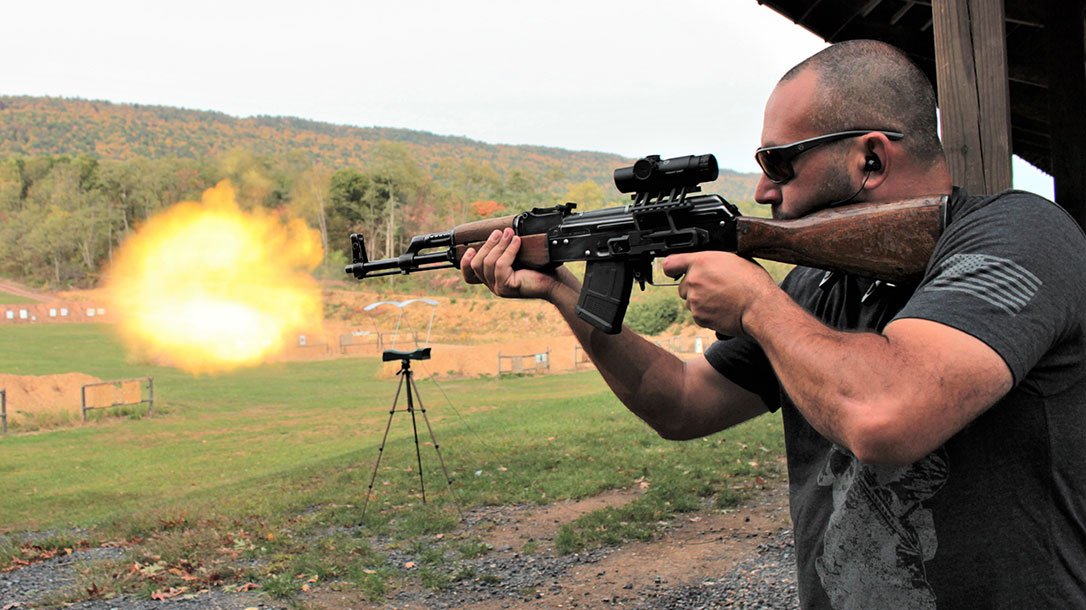It is claimed that the AR-15 can be chambered to fire more than 90 different cartridges. 7.62x39mm sits at the top of the list. We love this round because it is almost exclusively made with inexpensive steel cases. Not to mention, mother Russia just loves flooding our shores with it during times like these. Of course, picking up a $200 upper chambered in this short .30 caliber doesn’t end your ammo woes instantly. You’ll need some glass too. Like the GLx Prism from Primary Arms.
The Primary Arms GLx Prism Riflescope
The Texas-based manufacturer Primary Arms hit it out of the park years ago with its 5.56mm-based GLx 2x Prism Scope. And, as if they knew what was coming, created a nearly identical option that tracks 7.62x39mm or .300 Blackout out to 500 yards.
At the 2020 Athlon Outdoors Rendezvous, I got to lay my hands on the beta model of this scope. I knew instantly I wanted to do some more work with it at some clearly-defined ranges and targets.
Advertisement — Continue Reading Below
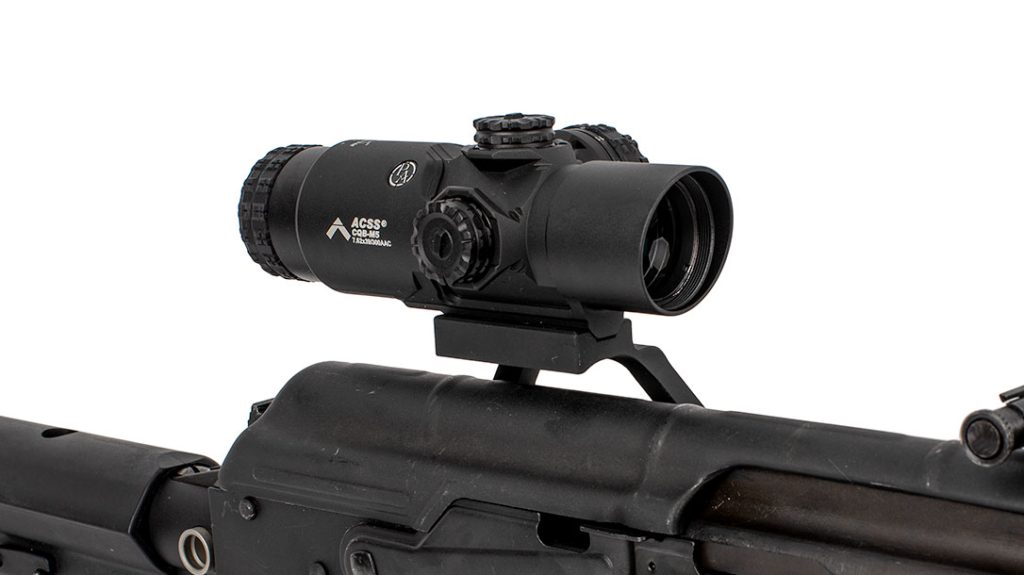
What’s a Prism Scope?
Prism scopes (or prismatic optics) sound super complicated, but the truth is they are far simpler than traditional scopes. Traditional scope gain magnification from a stack of lenses. However, prism scopes accomplish the same task with a single prism. Fewer internal parts mean fewer things that can go wrong and thus yields an inherently sturdier design.
Likewise, less glass means less between the shooter’s eye and the target. As a result, there is less distortion and better light and color transmission. Here comes my favorite part. Quality is achieved by the elimination of parts, therefore making the product better while reducing the cost. Man, is there no sweeter concept?!
Advertisement — Continue Reading Below
Yes, nothing is free in life as this design minimizes magnification. However, for a combat sight, field-of-view serves you better than zoom. So, for this design, it’s a win-win.
What’s In The GLx?
The MRRP of $369 gets you quite a bit in this compact 2x package. For starters, it’s one of the few optics in this price range with both automatic shut-off and automatic turn-on.
The AutoLive technology turns off after just three minutes of inactivity and turns back on at the tiniest movement. When Primary Arms says slight, they mean slight. As I type this, the vibration from the keyboard is turning on the optic sitting atop my desk. That’s important for me because, if I decide to keep this on my home-defense carbine, I need to be rest assured that it will turn on, no questions asked.
Advertisement — Continue Reading Below
If you are concerned with the battery dying because you plan on keeping your gun in your trunk or strapped across your chest, fret not because it is rated at 20,000 hours. Just remember to change it every other Christmas, and you’ll be fine without ever turning it off. Best of all, the etched reticle is completely visible and usable without illumination. So, if your battery does fail, you are not up the creek.
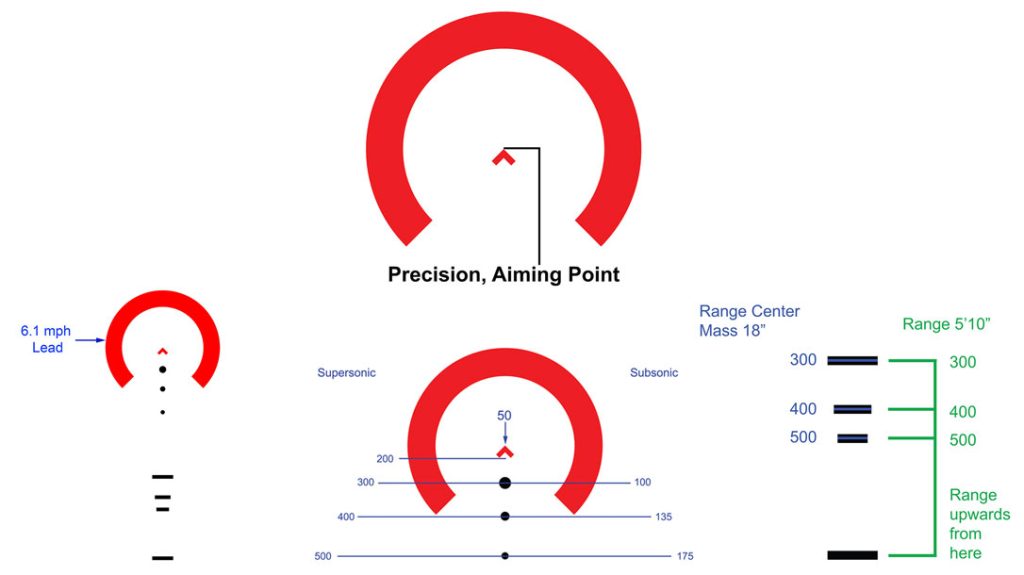
Shiny lights are cool, but the GLx is far more than a red dot. Using the ACSS-CQB-M5 reticle, it puts you on target from 50 yards out to 500 yards using pre-set holdover points. While optics with bullet-drop compensation are fairly common, finding one that actually works isn’t.
Advertisement — Continue Reading Below
These marks give you impact holds for 200, 300, 400, and 500 yards with both the 7.62x39mm round and supersonic .300 BLK, as they have a nearly identical trajectory. So a rock-solid BDC scope for under $400? All that was left was to add some guns and take a trip to my favorite proving ground.
The Guns & Mounting
AR-15s come in all shapes and sizes. So, you need to have flexibility in the manner in which you affix a scope. Furthermore, it isn’t the only platform that shoots 7.62x 39mm. Let’s not forget the AK.
For my test, I figured I would mix it up a bit so I could try the BDC with both cartridges that it was supposed to work with. Seeing that it’s far easier to find an AR in .300 BLK, I decided to make that the platform for that cartridge and revert to the classic AK-47 for the 7.62x39mm.
Advertisement — Continue Reading Below
For the AR, I swapped out the .223 barrel of my Frontier Tactical Warlock for its .300 BLK barrel and used the included Picatinny base to mount the GLx. My Lee Armory AK had a traditional side mount, so I used an RS Regulate setup to mate to the Mini ACOG underside of the second GLx, tightened down the screws, and I was all set.
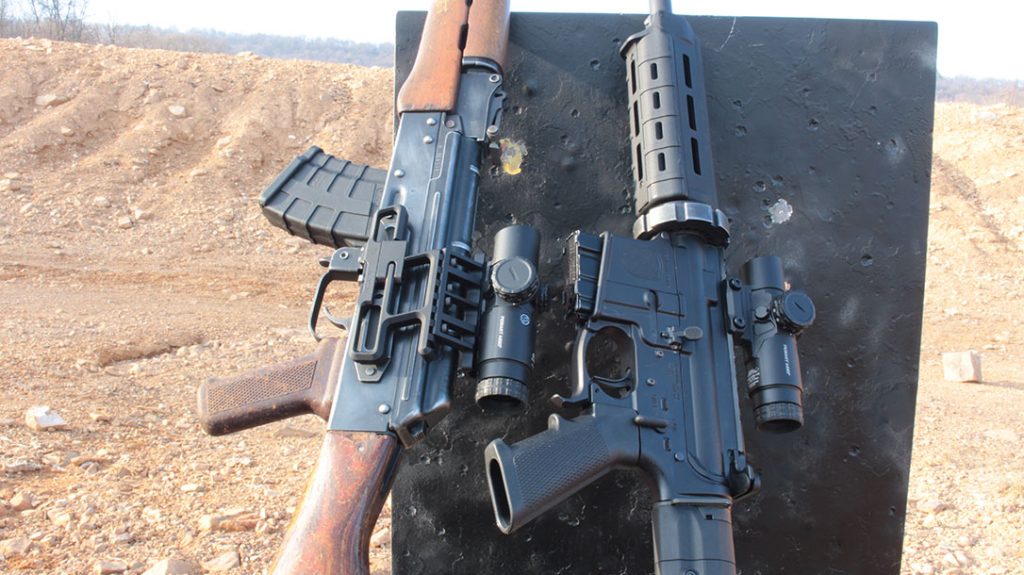
Primary arms include three different risers and the hardware to use any of them. During the process, I set the height right where I needed it for my particular cheek weld. It was one of the easiest installations that I’ve ever conducted, largely through the use of this mini ACOG system.
Advertisement — Continue Reading Below
Essentially, it’s a wedge that aligns the scope with the bore as the screw pulls the unit toward the base. Eliminating cant is especially important when you are using holdovers that are off-center. Just a few degrees of twist will introduce windage error when you put those lower dots on steel.
Range Report
After arriving and unpacking, I set some paper at 50 yards and then placed a full-sized Champion IPSC target at 200, 300, 400, and 500 yards. While the club has its own steel at these distances, it was important for me to do the legwork. Because I also wanted to check the GLx’s ranging stadia that sits at the very bottom of the glass.
The method is simple, just see which line stretches across an 18-inch target, and that target’s distance correlates with that particular line. IPSC targets measure a perfect 18 inches across. So, not only do they represent the proper size target for this weapon platform but the proper dimensions as well.
Advertisement — Continue Reading Below
The ACSS system relies on a 50-yard zero, hence the paper. Shooters are to zero the top of the chevron at this distance, and the bottom of the chevron will hit 200 yards. Correspondingly, the first dot down will hit 300, then 400, and the last 500.
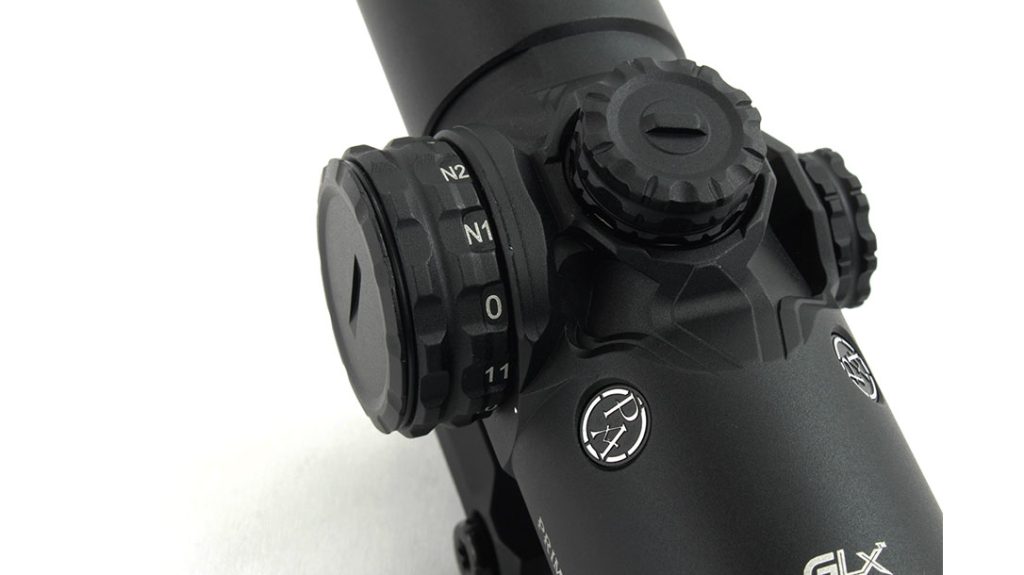
My goal was to test this with 123-grain Wolf 7.62x39mm and 110-grain HPR Tac-TX .300 Blackout. From a benchrest position, I zeroed both rifles for windage and elevation. The knobs are in ¼-MOA graduations, which is much finer than typical CQB optics. Also different is the direction that they turn. So, keep an eye on the arrows as clockwise is NOT down/left but up/right.
Advertisement — Continue Reading Below
I’m not going to lie, it took me a few extra rounds to zero because I kept messing this up. But zeroing is a set-it-and-forget-it endeavor, so not many points were lost because of this. A feature that I was fond of, however, was the integral adjustment tool built into the turret caps. This was all I needed to dial in, and also worked to remove the battery cover.
Zeroing For Distance
After zeroing as prescribed, we ran up the hill checking impacts and ranging bars out to 500 yards, using just the internal markings. Things were damn close for both rifles. However, we had to go back to our 50-yard target to zero just a few clicks higher or lower.
Remember, the adjustment that each click yields will increase dramatically with distance. So, a barely noticeable one-inch-high impact at 50 yards increases your 500-yard point of impact by 10 full inches!
Whenever you are setting up a BDC reticle, I recommend this method, as weather, barrel length, and, of course, ammunition are going to play a role in this relationship. On this particular day, we found that our .300 Blackout needed its 50-yard zero to be a hair lower. However, the 7.62x39mm set-up needed to be a hair higher.
Once we tweaked our zero, it was game on. It felt like we couldn’t miss a shot inside of 500 yards with either rifle!
Muscle Flexing
Towards the end of our range day, we tested the eyebox flexibility the only way I know how—unorthodox shooting. I figure a combat sight is rarely going to be used in ideal settings. So, I decided to engage targets off of a tank trap and off of a spool in a variety of positions. This includes off of my side and even shooting without any cheek weld whatsoever.
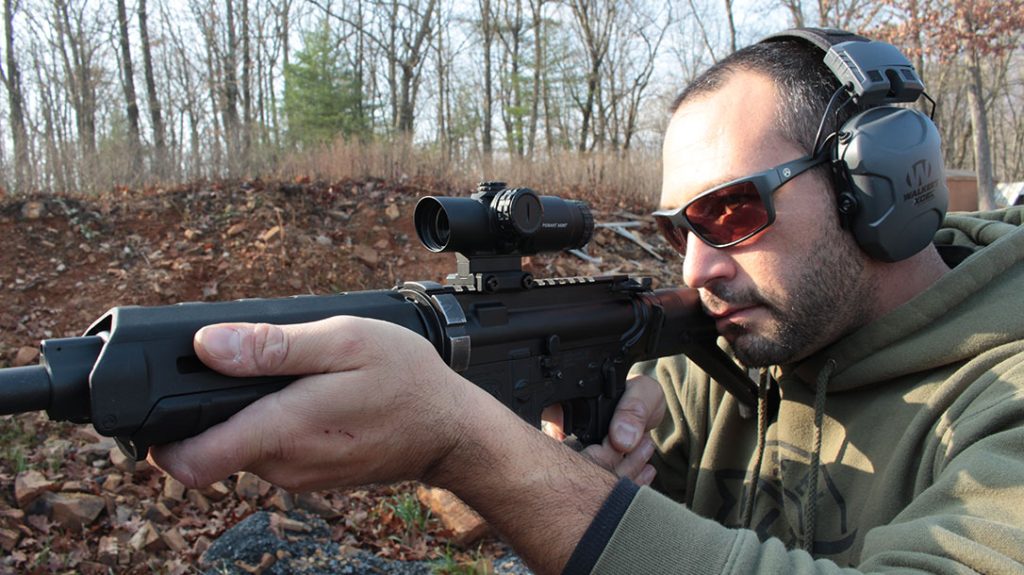
I found the reticle very easy to pick up when the gun was held at sharp angles to my face. Although proper eye relief is set around 3 to 4 inches, I was able to use the reticle even with the gun outstretched. This made it an imperfect scout or pistol scope as well.
Finally, we wrapped things up with an impromptu torture test as the AK took a dive off of the shooting bench and impacted the concrete with absolutely nothing breaking its fall. It turns out that while the shooting rest we had the rifle situated in was secure, it was no match for the blast coming off of the muzzle brake of the .338 Lapua firing just a few feet next to it. This is the very reason I practice safety rule #3: never load a gun until you are ready to shoot.
That event could have ended very differently otherwise. The scope landed square on the illumination knob, gouging it pretty badly, but that was the extent of the damage. Zero wasn’t affected, tracking wasn’t affected, and all the features worked the same as when we first mounted it. This may have been the most impressive aspect of our entire test.
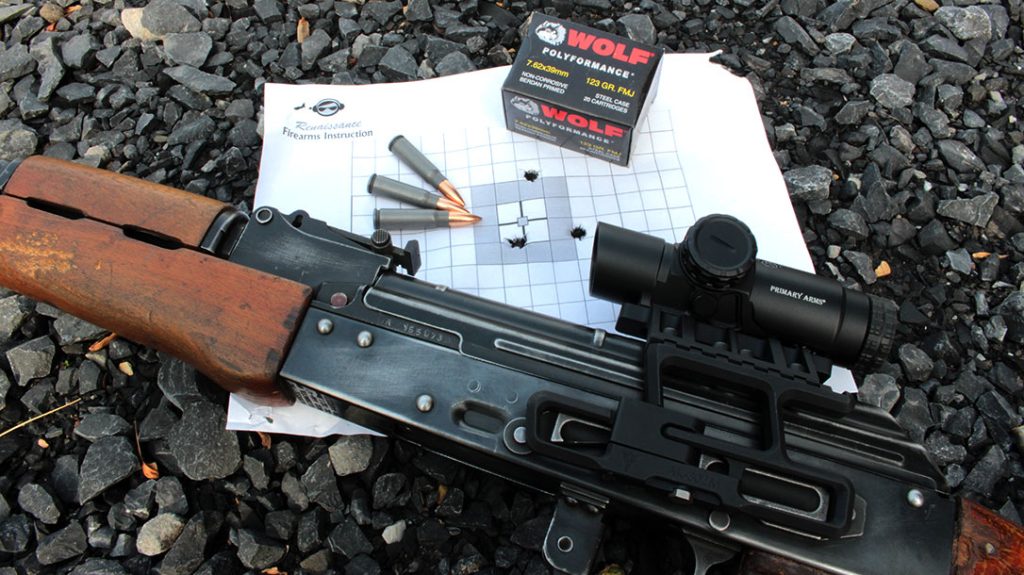
Parting Shots
Primary Arms continues to impress me with what they have to offer and at the low price points that they come in at. They seem to have a knack for nailing down BDC reticles too.
Before using their scopes, I used to bash this system to no end. However, as I continue to use them, my opinion is starting to change. Especially when we’re talking about combat effectiveness and smacking steel at intermediate distances.
While the horseshoe and chevron were illuminated and perfect for the fast target acquisition that CQB demands, it would have been nice if the BDC dots were illuminated too. Other than that, the 7.62-based Primary Arms GLx prism scope left very little to be desired. It makes a fine addition to any home-defense firearm or duty weapon. Particularly if you want to get out and have a little fun on some steel.
For more information, please visit PrimaryArms.com.
Primary Arms GLx Prism Scope Specs
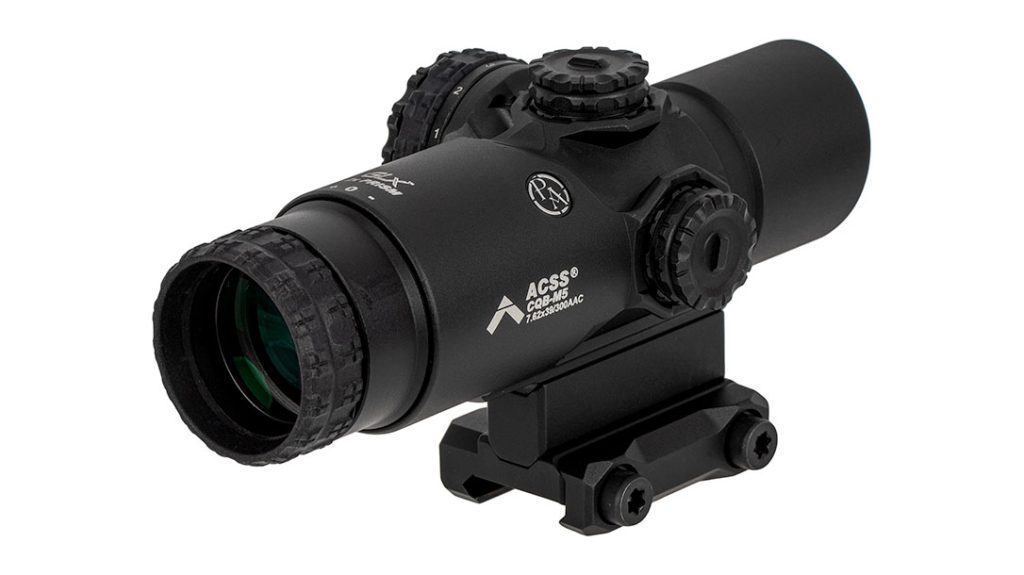
Battery Type: CR2032 3V Lithium Coin
Click Value: 1/4 MOA
Eye Relief: 3.50 inches
Field View @ 100 yards: 42 feet
Magnification: 2X
Night Vision Compatible: 2 modes
Reticle: ACSS CQB-M5 7.62
Total Elevation Adjustment: 40 MOA
Total Windage Adjustment: 40 MOA
Turret Features: Capped turrets, tool adjustable
Type: Fixed magnification
Weight: 11 Ounces
MSRP: $369.99
This article originally appeared in the January/February 2022 issue of Tactical Life magazine. Get your copy today at OutdoorGroupStore.com.
